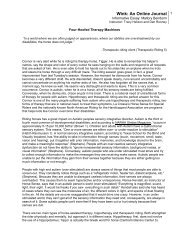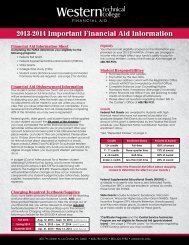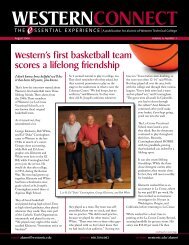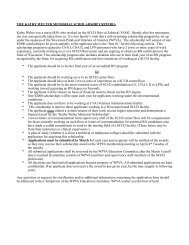The History of Western Technical College
The History of Western Technical College
The History of Western Technical College
Create successful ePaper yourself
Turn your PDF publications into a flip-book with our unique Google optimized e-Paper software.
in accordance with the needs <strong>of</strong> the individual to be trained along with related training. <strong>The</strong> commercial department<br />
provided the veteran with well-rounded business training. Space was provided in the Vocational School for the case<br />
supervisor <strong>of</strong> the State Board <strong>of</strong> Vocational and Adult Education Rehabilitation Division. A caseload <strong>of</strong> 450 persons was<br />
handled, with the supervisor providing services throughout La Crosse, Monroe, Vernon, Richland, Crawford and Grant<br />
counties. In addition, the school had a strong commitment to community enrichment, by encouraging appearances <strong>of</strong><br />
famous performers, orchestras, and actors, as well as providing a home for the La Crosse Symphony, a Civic Choir, and<br />
other similar groups.<br />
In 1945, the overall enrollment in individual classes as <strong>of</strong> the end <strong>of</strong> October was 1,860. Evening school registration for<br />
individual classes as <strong>of</strong> October 31 was 1,421.<br />
In May 1945, girls in the Vocational School Sewing class made garments for the Russian War Relief project. Pieces for<br />
the garments were sent to the school precut. <strong>The</strong> Russian War Relief furnished the cloth, thread, buttons, etc. <strong>The</strong><br />
sewing class completed 50 children’s flannel nightgowns, 25 little girls’ woolen dresses, 25 women’s wool skirts, and 10<br />
little boys’ overalls. For the past year, the class devoted approximately 2½ hours weekly to the project.<br />
June, 1945 – a new organization, the War Veterans’ Allied Council, was formed. It was composed <strong>of</strong> veteran’s<br />
organizations throughout the County and City <strong>of</strong> La Crosse.<br />
<strong>The</strong> Vocational Nursery School continued its operations for children 2 to 5 years <strong>of</strong> age. School facilities provided a<br />
variety <strong>of</strong> socialized training and entertainment for the youngsters while their mothers worked.<br />
May 7, 1945 – VE Day, Germany surrendered; August 6, 1945 – Atomic Bomb Exploded;<br />
September 2, 1945 – Surrender <strong>of</strong> Japan<br />
<strong>The</strong> war is over!<br />
“Now that the war is over we again are beginning to have demand for some <strong>of</strong> the courses we formerly taught.”<br />
In 1945, there were 4,508 persons enrolled – 3,764 in evening school and 744 in day school classes.<br />
In October 1945, the Board voted to employ an auto mechanics instructor at $2,800 per year and that new equipment<br />
would be purchased for the garage. <strong>The</strong> garage had been closed for three years and much modern equipment was<br />
necessary.<br />
In October 1945, the Vocational Board approved the budget for the 1946 school year in the amount <strong>of</strong> $117,630.<br />
Enthusiasm for the La Crosse Vocational and Adult Schools brought the Superintendent <strong>of</strong> Schools in Tuscon, Arizona, the<br />
Assistant Superintendent, and the senior high school principal to visit Director Coleman.<br />
“Your school is exceptionally well planned for the people <strong>of</strong> this community.”<br />
1945 Auditorium functions included . . .<br />
December 10 <strong>The</strong> 50-voice La Crosse Civic Choir, directed by Harold Youngberg, presented a concert <strong>of</strong> Christmas<br />
music.<br />
<strong>The</strong>re were no other concerts by the La Crosse Vocational Civic Choir in 1945 because the number <strong>of</strong> male participants<br />
had dwindled during the war.<br />
In 1946, the Vocational School Board Members were: J. G. Becker, president; R. H. Anderegg, vice president; Raymond<br />
C. Bice, secretary; Frank Papenfuss, and Dr. R. W. Bardwell, superintendent <strong>of</strong> schools.<br />
(Two employers, two employees, and one educational consultant.)<br />
As many changes had taken place in all aspects <strong>of</strong> living during the war years, one <strong>of</strong> the most extensive jobs <strong>of</strong> the<br />
school had just begun – that <strong>of</strong> counseling and giving advice to the returning GI’s and others. Servicemen returning<br />
home found many changes took place since 1941 and 1942 and also soon learned that the jobs they left had changed or<br />
were no longer there. Everyday, dozens <strong>of</strong> discharged servicemen sought guidance and advice from two veteran La<br />
Crosse Vocational School educators, Erwin L. Schreiber, superintendent <strong>of</strong> the trades and industry department, and<br />
George Howe, business manager and administrator <strong>of</strong> the Vocational School since 1941 and for 25 years before the<br />
business manager for the La Crosse Board <strong>of</strong> Education.

















